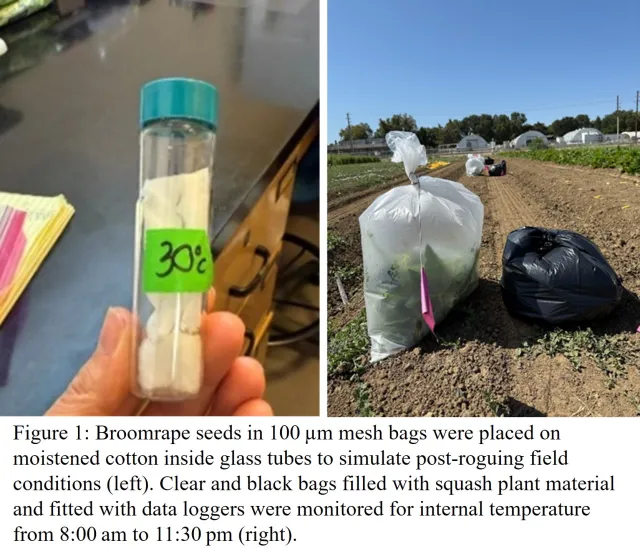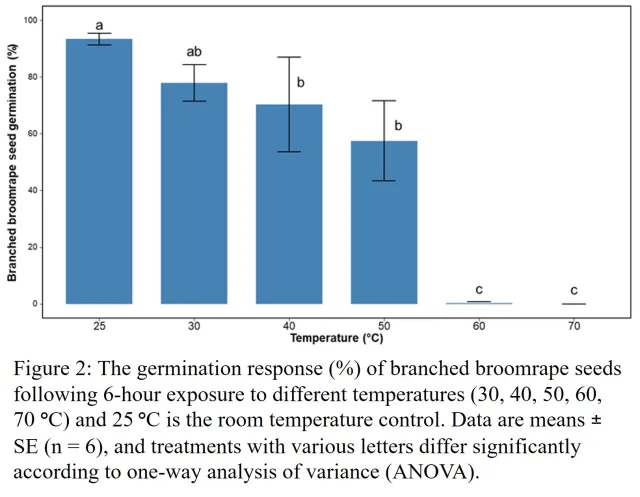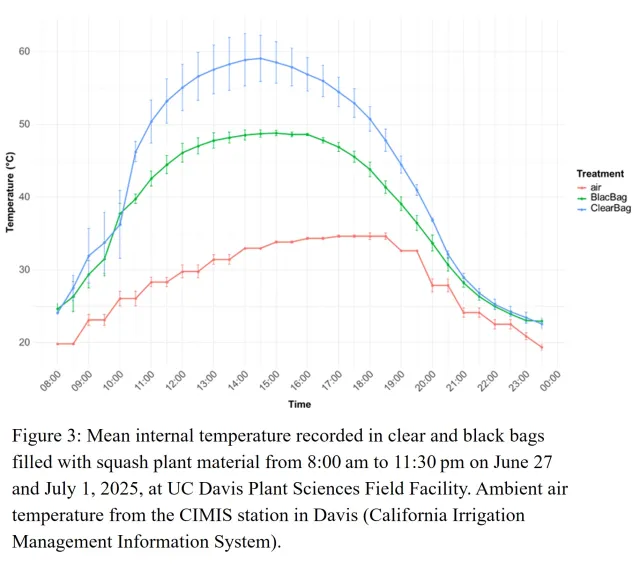Branched broomrape hand weeding and heat treatment
Pershang Hosseini, Magdalene Burgess, Rohith Vulchi, Ni Tang, Brad Hanson (UC Davis)
Introduction
Branched broomrape (Phelipanche ramosa) is an obligate root parasitic weed that can affect a wide range of crops, most notably processing tomato in California. This weed exhibits several unique biological characteristics that make it particularly difficult to manage; it relies entirely on its host for water and nutrients, cannot germinate without the presence of a host root, and produces thousands of tiny seeds capable of spreading easily and remaining dormant in the soil for many years. These traits present significant challenges for control and necessitate a multifaceted management strategy.
Handweeding to remove broomrape plants from the field before they make seed or before seeds are dispersed is a very important management tactic, particularly at early stages of infestation when there are relatively few seeds in the seedbank. Current recommendations are to remove plants from the field and leave the plant material in clear plastic bags where sunlight can heat the bags. This recommendation stems from research on soil solarization, which showed that soil heated above 45 °C (113 °F) for several weeks reduced broomrape seed viability by 95% (Mauromicale et al. 2005; Gebreegziher et al. 2023). However, no data are available that are directly applicable to handweeding and “air solarizing” broomrape seed in the California production system. This study aims to explore whether air solarization can serve as a practical tool for reducing the germinability of broomrape seeds that may be present in hand-weeded plant material.
Methods
The thermal response part of this experiment was conducted in the broomrape-designated laboratory at UC Davis in 2025 to determine temperatures lethal for broomrape seed germinability. Broomrape seeds were sealed in fine mesh nylon bags (100 microns) and placed on top of a moistened half cotton ball containing 2 mL of distilled water inside a glass tube, simulating conditions similar to those experienced by bagged plant material hand-rogued from infested fields (figure 1-left). The tubes were placed in a temperature-controlled oven for 6 hours. Treatments included constant temperatures of 30 °C (86 °F), 40 °C (104 °F), 50 °C (122 °F), 60 °C (140 °F), and 70 °C (158 °F). Room temperature (25 °C [77 °F]) served as the untreated control. Each treatment included three replicates, and the entire experiment was conducted twice.

After incubation, all seeds were removed from the bags and placed onto Whatman filter paper in 60 mm diameter Petri dishes. One milliliter of deionized water was added to each dish, which was then sealed with Parafilm and kept in darkness at 25 °C (77 °F) for ten days for preconditioning. Following preconditioning, the Petri dishes were unsealed and air-dried. Then, 0.7 mL of GR24 (a synthetic germination stimulant) was added to each dish. The dishes were resealed with Parafilm and returned to the dark incubator at 25 °C (77 °F) to allow germination and radicle elongation. Ten days after GR24 treatment, the Petri dishes were unsealed and left to partially dry overnight to reduce surface sheen from free water before imaging. Germinated and non-germinated seeds were counted manually from the images, and the percentage of germination was calculated for data analysis.
To evaluate the temperature conditions that can realistically be achieved and sustained in the field—and for how long—an experiment was conducted in the outdoor environment at UC Davis Plant Sciences Field Facility near Davis. Temperatures were monitored from 8 am to 11:30 pm in plastic bags filled with fresh squash leaf and vine material in place of broomrape plant material for humidity and heat retention. Two types of bags were used: clear bag (Autoclave bag 24*36 inches, 2mm) and black bags (15 gallon ‘Tough Guy’ can liner). Bags were sealed, and one Kestrel DROP D2 Bluetooth Data Logger was placed inside each bag to record internal temperature (figure 1-right). Ambient air temperature data recorded from the CIMIS station in Davis (California Irrigation Management Information System) were used for comparison purposes. Data were collected from two replicates under each condition on June 27 and an additional two on July 1, 2025.
Results
Results from the heat experiment in the lab showed that branched broomrape seed germinability decreased as incubation temperature increased from 30 °C (86 °F) to 50 °C (122 °F), and no germination was observed when seeds were exposed to temperatures above 60 °C (140 °F) for six hours (Figure 2).

When data from the outdoor experiments were evaluated, internal temperatures varied by bag type throughout the day (Figure 3). Clear bags consistently reached the highest temperatures, peaking between 50 °C and 60 °C (122–140 °F) and sustaining these levels for approximately 7 hours. Black bags also showed elevated temperatures, ranging from 40 °C to 50 °C (104–122 °F) during the same period, but maximum temperatures remained lower than those in clear bags. These results indicate that clear bags are more effective at trapping solar heat and maintaining high internal temperatures under field conditions, potentially enhancing broomrape seed devitalization.
This study demonstrates that branched broomrape seeds lose germinability when exposed to sustained temperatures above 60 °C (140 °F) in controlled conditions. In the field, internal temperatures inside clear plastic bags approached 60 °C (140 °F) and were sustained near that level for several hours, indicating that seed-lethal temperatures may be achievable under typical summer conditions. While handweeding remains an essential tactic to prevent seed return to the soil, the risk of post-pulling seed maturation highlights the need for proper disposal of broomrape biomass. “Air solarization” of hand-pulled broomrape plants—by sealing them in clear plastic bags and leaving them in the sun for several hours—offers a simple, low-cost strategy that could help devitalize seeds still present in the removed plant material.

For growers facing broomrape infestations, this approach could complement existing handweeding efforts and reduce the long-term seedbank burden. While more work is needed to confirm the relationship between internal bag temperature and seed kill under varied field conditions, this method provides a promising, practical tool for reducing broomrape seed viability after removal from the crop.
References
Gebreegziher WG, Alemu ,A. Kidanu, Zebib, K., and Tarekegn Y (2023). Application of soil solarization and manure, individually and in combination, control broomrape infestation and improve tomato yield. Int J Veg Sci 29:205–214
Mauromicale G, Monaco AL, Longo AMG, Restuccia A (2005). Soil solarization, a nonchemical method to control branched broomrape (Orobanche ramosa) and improve the yield of greenhouse tomato. Weed Sci 53:877–883
